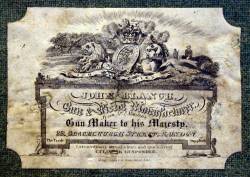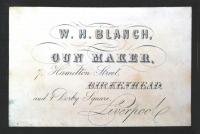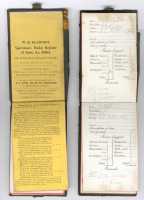|
A Brief History of J Blanch & Son |
old
The first John Blanch was born in 1784 and at the age of 16 was apprenticed
within the Farriers Company to Jackson Mortimer, a prestigious London
gunmaker. In approximately 1807, having finished his apprenticeship, he
married his master's daughter, Ann, and moved on to work for the famous
John Manton, probably until 1809. He then established his own business
although the precise nature and whereabouts are unknown. It has been suggested
that he shared workshops with Alexander Wilson of 14 Titchbourn Street,
London and this might seem reasonable as Alexander had been apprenticed
to John Manton, setting up on his own in 1805.
Quite why Jackson Mortimer was a liveryman of the Farriers Company rather
than the Gunmakers Company is unclear but it may be for historical reasons
connected with the earliest origins of gunmakers within the blacksmith
trade.
Whatever the reason, John Blanch went on to become a 'Freeman' of the
Farriers Company in 1811, was elected 'Assistant' in 1827, 'Rento Warden'
in 1831, 'Middle Warden' in 1832, 'Upper Warden' in 1833 and 'Master'
in 1834. The 'Master' is the top appointment within the Farriers
Company and confers great prestige upon its incumbent. It can be
seen by his swift elevation within the Farriers Company, that John Blanch
had become a highly respected businessman of the age.
However, I digress. In 1811 he returned to form a partnership with
Jackson Mortimer as Mortimer & Blanch but this apparently only lasted
one year and in 1813, at the age of 29, he set up on his own at 39 Fish
Street Hill.
The move to 29 Gracechurch Street came in 1826 where the firm remained
for 89 years.
| < An early 29 Gracechurch Street trade label without '& Son' therefore between 1826 and 1848. |
John
Blanch had three sons who were all apprenticed to him, again within the
Farriers Company.
The eldest son, also John, born 1812, was apprenticed to his father in
1827 and became a freeman of the Farriers Company by patrimony in 1835,
having married Sara Witt in 1833.
In
1832 John Blanch snr had bought the gunmaking concern of Robert Williamson
at 26 Silver Street, Hull and in 1836 sent John Blanch jnr to run it.
This was not a great success, John jnr emigrated to Australia later the
same year and the business was sold to Samuel Mozeen in 1838.
John's emigration may have been connected to a legal dispute regarding
a patent. In 1835 a Professor Murray patented a line throwing gun and
commissioned a prototype from John Blanch in Hull. A short while later,
John jnr was seen to be advertising this very same gun under his own name
in breach of the patent protection and a legal action was initiated.
Sara was already pregnant when she and John sailed and there second son,
William Harnett, was born as the ship crossed the equator.
The family settled in Tasmania and then moved to Melbourne in 1838.
On 17th December 1839 both Sara and John were blown up in their Melbourne
shop in a cartridge loading accident. This was the day after his gunmaker
uncle, Henry William Mortimer (child of Jackson Mortimer), arrived in
Melbourne.
|
Tin
of percussion caps, in Blanch labeled tin with original lining.
>
Date unknown. |
The
second son, Henry Mortimer (named after his grandfather) was born in 1817,
apprenticed to his father in 1831 and became a freeman of the Farriers
Company and also married in 1839. He supposedly emigrated to Australia
in 1843 but a Henry Mortimer Blanch was recorded in business in Southampton
in 1843 so perhaps the business failed and he then left for Australia.
He is known to have fathered 13 children whose descendants form a large
family clan in Australia and New Zealand.
Their
third son, William, born 1822 remained to work with his father. He was
apprenticed to his father in 1836 and became a freeman of the Farriers
Company in 1843.
In 1848 William became a partner in the firm, from then known as John
Blanch & Son.
This name change helps to date early Blanch guns that do not display the
'and Son'.
| < John Blanch trade label, probably 1848 to around 1880 fitted in the case for a double barrelled 14b percussion gun, no. 2105. |
Soon after this the orphaned William Harnett Blanch, born 1836, grandson of the founder and son of the eldest son John, returned from Australia to be apprenticed to his uncle William in 1851. After completing his apprenticeship and becoming a freeman of the Farriers Company in 1859, he founded W H Blanch of Liverpool in 1861 and became a prolific writer and inventor, especially of rifle sights and accessories.
|
In
1841 John Blanch snr was living at 25 Hanover Street, Camberwell. It is
not known when he died but if he was still alive in 1860 he would have
been 76 years old.
William Blanch died in 1899 at the age of 77 and an obituary was published
in the October, 1899 edition of the periodical Arms and Explosives.
To read this Click Here.
It seems that Herbert John Blanch succeeded him.
|
< John Blanch trade label, probably dating from around the 1880's.
|
In 1904 the firm took additional premises at 15 Broad Street Place but closed them again in 1907.
1909 saw the publication of 'A Century of Guns' by H J Blanch. If for no other reason, this book is interesting in that it may be the first historical book on firearms that used photographic illustrations rather than engravings. He also held the post of Chairman of The Gunmakers Association for the years 1902, 1904 and 1917.
In 1915, while Europe was in the grip of the 1st World War, John Blanch & Son moved to 20 Cullum Street after financial difficulties. Problems of this kind were not at all uncommon in the gun trade during these turbulent times. Many gamekeepers and patrons of the country's gun trade were wounded or killed in the trenches and to a large extent the hostilities brought an end to the heyday of the sporting gun trade.
|
20
Cullum Street trade label, 1914-1928 >
|
Ironically,
the war inspired several of the very few Blanch patents. As we have said
elsewhere, Blanch were not a particularly innovative gun maker, tending
to use tried and tested mechanisms patented by their colleagues in the
gun trade. However, H J Blanch broke the mould somewhat by obtaining at
least two patents himself plus one with G J Stevens and one with A L Chevallier
. These were no. 8967 of 1899, a single trigger design; 12426 of 1906,
a Lee Enfield rifle modification; 25538 of 1909 with G J Stevens, a sighting
accessory, and finally 101018 of 1916 with A L Chevallier, a muzzle grenade
launcher.
1928
saw a move to 96 York Road, Lambeth, SE1 which may possibly have been
the home address of H J Blanch. In 1931 Blanch moved to 40 Pall Mall and
in 1933 they bought the business of J Barrett (& Son) and moved to
6 Mitre Street, Aldgate, EC3.
Europe was plunged in to war again in 1939 and in 1942 a single bomb struck
the Blanch workshops and destroyed all their records.
From 1942 to 1976 the business was run by Frederick Wood on behalf of
H J Blanch and apparently concentrated mainly on trade work.
In the book The House of Churchill by Don Masters, Frederick Wood is described as a 'provincial gun dealer who also dabbled in antiques'. The book relates that:
'Frederick Wood, the gun dealer, had been a friend of the Blanch gunmaking family and had taken over the management of the business from Herbert John Blanch before World War II. Fred confided that one of the reasons for the firms prosperity in the 1930's was its location in the city of London. He told endless stories of punters who had made money on the stock exchange and then spent their winnings on pairs of Blanch guns. He always boasted that in the 1930's Blanch sold more guns in pairs than most other London gunmakers. I was negotiating to buy the name of Blanch from Fred at the time of his sudden death in the mid 1970's.'
(It should be noted that no pairs of guns made later than 1905 have so far been entered in the database. In fact guns from the 1930's seem to conspicuous only by their rarity. TB)
Not withstanding the above tale, the name was not sold and the baton was taken up in 1976 by a relation, Derek Arnold, who for a time operated from a retail outlet near Grantham, Lincolnshire.
In 2010 Mr Mark Eeley aquired the company name from Mr Arnold and is offering repair and refurbishment for Blanch guns. He can be contacted on http://www.jblanchandson.co.uk.
I would like to thank Mr Bill Blanch (great great grandson of the first John Blanch) for additional family history details; Mr Derek Arnold, ex-owner of John Blanch and Son (Gun & Rifle Makers) Ltd; David Baker, author and gun historian; Bill Harriman, BASC Head of Firearms and the late Geoffrey Boothroyd who have in the recent and distant past all selflessly provided me with much of the background information and encouragement in my researches.
Last but not least I would like to thank the Internet Gun Club for permission to use their John Blanch and Son entry and furthermore supplied several of the trade label images shown above.
Bibliography:
London
Gunmakers, Nigel Brown, 1998.
Boothroyd's revised Directory of British Gunmaker, Geoffrey & Susan
Boothroyd, 1997
Sidelocks & Boxlocks, Geoffrey Boothroyd. 1991
Shotguns & Gunsmiths The Vintage Years, Geoffrey Boothroyd. 1986
The House of Churchill, Don Masters.






